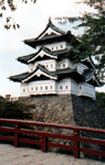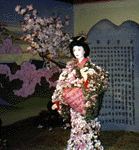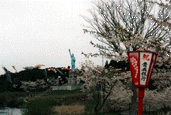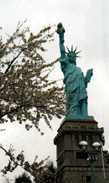| The name Nebuta is known throughout Japan.
It refers to huge, illuminated floats which are carried
through the streets of Aomori to the sound of beating
drums each August during the Nebuta Festival. |
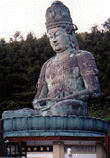 Since 1984, Aomori has been home to the Showa Daibutsu (Largest Buddha) in all of Japan.
Dainichi Nyorai, the name of this image of Buddha, is the symbol of unlimited wisdom, kindness, and inner power.
Since 1984, Aomori has been home to the Showa Daibutsu (Largest Buddha) in all of Japan.
Dainichi Nyorai, the name of this image of Buddha, is the symbol of unlimited wisdom, kindness, and inner power. |
| The Daibutsu stands seventy feet high and weighs 220 tons. You may remove your shoes and walk inside the Buddha.
Here you will see metal plates covered with the names of Japanese soldiers who died in WW II.
Here we pray to Buddha or God to ensure the happiness of these soldiers and of American soldiers as well. |
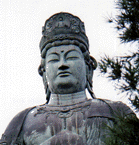 |
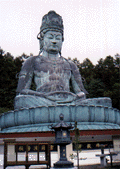 This largest Buddha was built because of the fundraising efforts of two monks, Oda Ryukoh and Oda Ryugen, who are father and son.
They wanted to build the Buddha to appeal to Japanese to turn their backs on materialism and the struggle to get into the right
school to get the right job, and return instead to the buddhist precepts of patience, purification, endeavor and rewarding good and punishing evil.
This largest Buddha was built because of the fundraising efforts of two monks, Oda Ryukoh and Oda Ryugen, who are father and son.
They wanted to build the Buddha to appeal to Japanese to turn their backs on materialism and the struggle to get into the right
school to get the right job, and return instead to the buddhist precepts of patience, purification, endeavor and rewarding good and punishing evil.
|
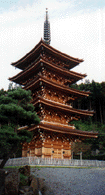 When you arrive to see the largest Buddha, you will first see the grand Kondou or main hall of
the Seiryuji Temple. You are free to enter, unless the priests are praying. Inside you will find various objects of
worship enshrined, including a model of the largest Buddha.
When you arrive to see the largest Buddha, you will first see the grand Kondou or main hall of
the Seiryuji Temple. You are free to enter, unless the priests are praying. Inside you will find various objects of
worship enshrined, including a model of the largest Buddha. |
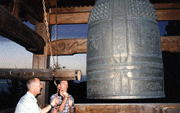 Along the path to the Showa Daibutsu, one of the next items you come upon is the massive temple bell.
For 100 yen, you can ring the bell. Ringing bells or chimes and clapping hands are common ways to alert the gods that you are going to pray to them.
Along the path to the Showa Daibutsu, one of the next items you come upon is the massive temple bell.
For 100 yen, you can ring the bell. Ringing bells or chimes and clapping hands are common ways to alert the gods that you are going to pray to them. |
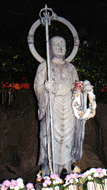 The first statues you see are the Jizou Bosatsu for children who have passed away. Parents leave their child's favorite toy,
candy, or piece of clothing here. Often, the clothing is placed right on the statue. Notice the pinwheels behind the statue.
The first statues you see are the Jizou Bosatsu for children who have passed away. Parents leave their child's favorite toy,
candy, or piece of clothing here. Often, the clothing is placed right on the statue. Notice the pinwheels behind the statue. |
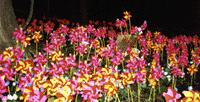 Behind and alongside the Jizou Bosatsu is an array of colorful pinwheels. These pinwheels are purchased at the site and placed here
by parents to entertain the spirits of children who died by abortion. Sadly, there are hundreds of pinwheels.
Behind and alongside the Jizou Bosatsu is an array of colorful pinwheels. These pinwheels are purchased at the site and placed here
by parents to entertain the spirits of children who died by abortion. Sadly, there are hundreds of pinwheels. |
 Nearby to the Showa Daibutsu is the Sannai-Maruyama site. During construction of a baseball field here in 1994,
relics from the Jomon people, who lived 5000 years ago, were unearthed. The relics include pit dwellings and a pillar structure.
Adult and infant cemeteries have also been uncovered and preserved on this site.
Nearby to the Showa Daibutsu is the Sannai-Maruyama site. During construction of a baseball field here in 1994,
relics from the Jomon people, who lived 5000 years ago, were unearthed. The relics include pit dwellings and a pillar structure.
Adult and infant cemeteries have also been uncovered and preserved on this site. |
Even if you can't come to Momoishi, chances are that you can experience another of the town's claims to fame right where you are. Momokawa Brewery, located in Momoishi, produces a sake that has won 46 consecutive gold medals and consistently been named the best in Japan. It is exported around the world, so look for some today. As you enjoy the sake, you too will have to consider how truly small the world really is.
 This bronze statue of Buddha was cast in 1252. It was initially covered by a temple, but has been exposed to sun, storms, and snow since 1498 when a tidal wave destroyed its covering temple. The statue is 13.35 meters tall and weighs 121 tons. Visitors can climb stairs inside the Great Buddha. This bronze statue of Buddha was cast in 1252. It was initially covered by a temple, but has been exposed to sun, storms, and snow since 1498 when a tidal wave destroyed its covering temple. The statue is 13.35 meters tall and weighs 121 tons. Visitors can climb stairs inside the Great Buddha.
|
|
| |
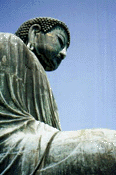 Not too well seen in this view, but present just above the nose, is the pure silver curl on the Buddha's forehead, which is believed to emit rays of light to illuminate all the worlds in the universe, similar to the Bible scripture "I am the light of the world." The long ears are characteristic of images of Buddha.
Not too well seen in this view, but present just above the nose, is the pure silver curl on the Buddha's forehead, which is believed to emit rays of light to illuminate all the worlds in the universe, similar to the Bible scripture "I am the light of the world." The long ears are characteristic of images of Buddha. |
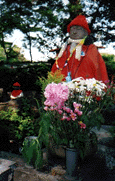 Also located in Kamakura is the Hase Kannon Temple, home to Juichimen Kannon, a Buddha with eleven faces. Out of respect, I was unable to take a photo.
However, here is a photo of Jizo. As discussed above, these statues of Jizo are placed to pray for the souls of children
who were stillborn, miscarried, or killed by abortion.
Also located in Kamakura is the Hase Kannon Temple, home to Juichimen Kannon, a Buddha with eleven faces. Out of respect, I was unable to take a photo.
However, here is a photo of Jizo. As discussed above, these statues of Jizo are placed to pray for the souls of children
who were stillborn, miscarried, or killed by abortion. |
When you visit Tokyo, a trip to Kamakura will be an essential part of your trip. Besides the many temples and shrines, numerous shops and restautrants abound.
 |
While this may resemble a Motel 6, this "Soundpark" provides
individual karaoke cabins, allowing small groups to eat, drink, and sing their hearts out. |
| Just down the street from the Soundpark stands a bank of vending machines. Nothing unusual there, except that they sell Beer! |
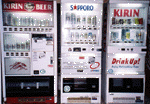 |
 |
When I say you can get anything from a vending machine in Japan, I mean anything. This machine sells a dozen eggs for 200 yen. By the way, there are 10 eggs to a dozen in Japan.
It's the metric system after all! |
| Undoubtedly you're familiar with The Dollar Store. Well they have them in Japan too, only here it's the 100 Yen Store. |
 |
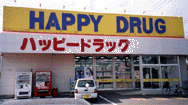 |
I love the name of this store. You'll notice many English signs
in Japan, usually also spelled in katakana, which is one of Japan's three alphabets, used to spell foreign words. The Japanese here spells out "ha"
(followed by tsu which means to double the next sound) "pi" (the dash makes a long vowel sound) "do" "ra" (again double the next sound) "gu", or ha-pi-do-ra-gu, or happy drug. Easy, huh? |
| No matter what business you visit in Japan you're sure to find maneki-neko, this good luck cat. |
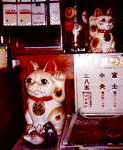 |
 |
Good luck symbols are all over Japan. These charms, hanging in a car window, are purchased at shrines and protect travelers. Similar charms dangle from kid's backpacks or housewive's key rings. |
| This is another common sign in Japan, or at least in Northern Japan. This symbol looks like the hot water it represents. It marks an
onsen or hot bath. These baths used to serve as a family's only way to get clean. Now they are simply a great way to relax and wash away the stress of everyday life. |
 |
 |
Would you believe that in Japan official documents aren't signed, but stamped? This rack shows some inexpensive name stamps, or hanko. More expensive, hand-made hanko are used as a signature. |
| Junior and Senior High School students are required to wear uniforms in Japan. These girls add an individual touch with those super loose socks. |
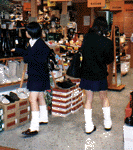 |
 |
While not too unusual, the mailboxes are a little different. That "T" with the line over it stands for mail, and is seen wherever a business has a mailbox. |
| Self service gas stations are essentially unknown in Japan. After filling your tank, emptying your ashtray of "smoking dust," and cleaning all your windows, the attendant will politely bow after stopping traffic to allow you you to pull out. |
 |
 |
Well, time to stop, and that's just what this says. You guessed it. That's a Japanese stop sign. |
 Since 1984, Aomori has been home to the Showa Daibutsu (Largest Buddha) in all of Japan.
Dainichi Nyorai, the name of this image of Buddha, is the symbol of unlimited wisdom, kindness, and inner power.
Since 1984, Aomori has been home to the Showa Daibutsu (Largest Buddha) in all of Japan.
Dainichi Nyorai, the name of this image of Buddha, is the symbol of unlimited wisdom, kindness, and inner power.
 This largest Buddha was built because of the fundraising efforts of two monks, Oda Ryukoh and Oda Ryugen, who are father and son.
They wanted to build the Buddha to appeal to Japanese to turn their backs on materialism and the struggle to get into the right
school to get the right job, and return instead to the buddhist precepts of patience, purification, endeavor and rewarding good and punishing evil.
This largest Buddha was built because of the fundraising efforts of two monks, Oda Ryukoh and Oda Ryugen, who are father and son.
They wanted to build the Buddha to appeal to Japanese to turn their backs on materialism and the struggle to get into the right
school to get the right job, and return instead to the buddhist precepts of patience, purification, endeavor and rewarding good and punishing evil.
 When you arrive to see the largest Buddha, you will first see the grand Kondou or main hall of
the Seiryuji Temple. You are free to enter, unless the priests are praying. Inside you will find various objects of
worship enshrined, including a model of the largest Buddha.
When you arrive to see the largest Buddha, you will first see the grand Kondou or main hall of
the Seiryuji Temple. You are free to enter, unless the priests are praying. Inside you will find various objects of
worship enshrined, including a model of the largest Buddha. Along the path to the Showa Daibutsu, one of the next items you come upon is the massive temple bell.
For 100 yen, you can ring the bell. Ringing bells or chimes and clapping hands are common ways to alert the gods that you are going to pray to them.
Along the path to the Showa Daibutsu, one of the next items you come upon is the massive temple bell.
For 100 yen, you can ring the bell. Ringing bells or chimes and clapping hands are common ways to alert the gods that you are going to pray to them. The first statues you see are the Jizou Bosatsu for children who have passed away. Parents leave their child's favorite toy,
candy, or piece of clothing here. Often, the clothing is placed right on the statue. Notice the pinwheels behind the statue.
The first statues you see are the Jizou Bosatsu for children who have passed away. Parents leave their child's favorite toy,
candy, or piece of clothing here. Often, the clothing is placed right on the statue. Notice the pinwheels behind the statue. Behind and alongside the Jizou Bosatsu is an array of colorful pinwheels. These pinwheels are purchased at the site and placed here
by parents to entertain the spirits of children who died by abortion. Sadly, there are hundreds of pinwheels.
Behind and alongside the Jizou Bosatsu is an array of colorful pinwheels. These pinwheels are purchased at the site and placed here
by parents to entertain the spirits of children who died by abortion. Sadly, there are hundreds of pinwheels. Nearby to the Showa Daibutsu is the Sannai-Maruyama site. During construction of a baseball field here in 1994,
relics from the Jomon people, who lived 5000 years ago, were unearthed. The relics include pit dwellings and a pillar structure.
Adult and infant cemeteries have also been uncovered and preserved on this site.
Nearby to the Showa Daibutsu is the Sannai-Maruyama site. During construction of a baseball field here in 1994,
relics from the Jomon people, who lived 5000 years ago, were unearthed. The relics include pit dwellings and a pillar structure.
Adult and infant cemeteries have also been uncovered and preserved on this site.